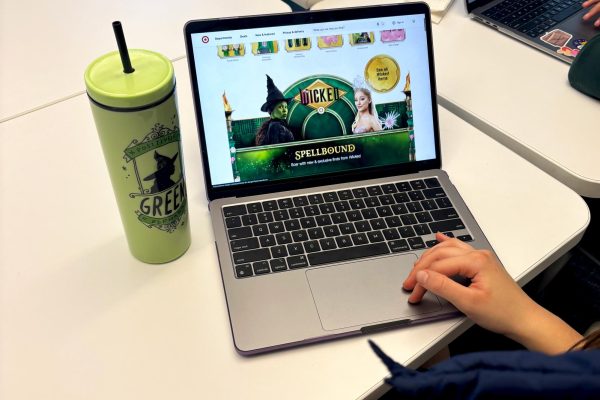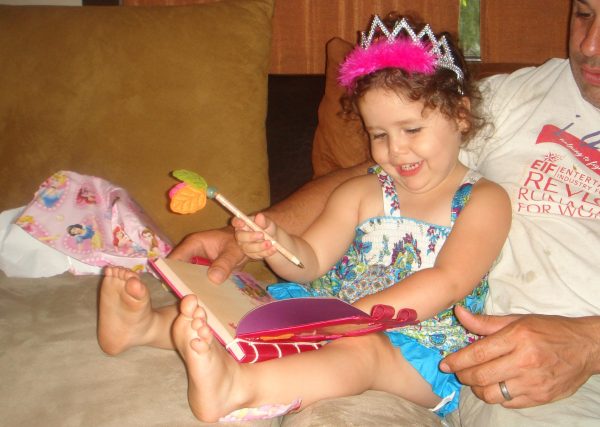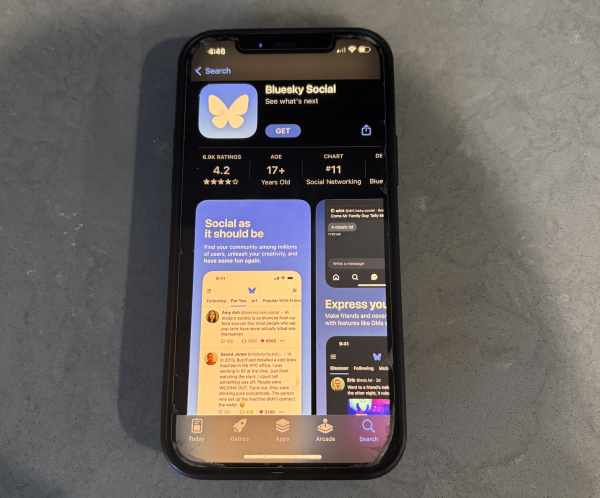Op-Ed: STEM-centered education risks alienating arts and humanities students
Photo credit: Eloise Rollins-Fife
These lab coats are a staple of Archer’s science classrooms and were introduced for the 2015 STEM Symposium. Focus on STEM-centered education can often leave students interested in other disciplines feeling overlooked.
If, like me, you’ve spent your life immersed in the ‘soft’ disciplines, a term commonly applied to the arts and humanities, you might have been (justifiably) upset by Wells Fargo’s September ads.
The print ads, which I’ll forgive but never forget, showed presumably teenaged models tinkering with microscopes, test tubes and other scientific tools. On the first page, there’s a picture of an excited-looking girl in her lab, with the words “A ballerina yesterday. An engineer today,” and the campaign’s slogan “Let’s get them ready for tomorrow” superimposed on top. In the second, a boy happily plays with a test tube full of dirt and is similarly displayed under a banner stating, “An actor yesterday. A botanist today. Let’s get them ready for tomorrow.”
Apparently, tomorrow is full of budding botanists and utterly devoid of artistic expression. Cool.
Wells Fargo has since apologized for the offending campaign, but clearly they brought to light an issue that’s become pervasive in modern American culture: the systematic devaluing of the humanities and arts in favor of STEM-based (Science, Technology, Engineering and Math) programming.
That’s absolutely not to say, of course, that STEM isn’t important. Technological growth and scientific progress have been and will continue to be hallmarks of a productive society. Where would we be without the advancements in medicine that have allowed for mass vaccination? The computer programming that’s given us iPhones and laptops and revolutionized our global communication? The biological discoveries that have illuminated the origins of our world? Certainly in a very different place.
However, it’s vital that we don’t forget about the schools of philosophical thought that allow us to track our world’s progression or the vibrant artistic communities that inject life into our culture.
There’s a broad political trend of denouncing the humanities in favor of tech-based education, especially for girls. This is obviously not without its logic or benefits; we’ve all heard the statistic that women comprise only 24 percent of the STEM workforce, and it’s absolutely true that this is a problem that needs addressing. We should be encouraging girls to explore the maths and sciences — if they want to.
If they don’t, however, let’s stop making them feel like they’re worthless in today’s job market or social climate. A 2015 Forbes article revealed that powerhouse tech companies such as Slack have focused their talent searches on recipients of non-STEM-related degrees, because, as Forbes puts it, “The more that audacious coders dream of changing the world, the more they need to fill their companies with social alchemists who can connect with customers–and make progress seem pleasant.”
In other words, the world —even the corporate one — needs all types of thinkers to thrive. If everyone became an engineer or a botanist, sure, we’d have a lot of cool software and impressive plants, but we’d lose TV, movies, theater, visual art, literature, journalism and all the people who make those things, as well as government policy-makers, educators, activists, designers and a whole host of other vitally important members of society.
Additionally, the arts and humanities are worthwhile not only for those who intend to pursue them as a career, but for everyone, mathematicians and scientists included. A huge part of any job is writing, and it’s critical to develop strong English skills to succeed in all fields. Historical and civic knowledge is important for all members of a democratic society to possess, and something that has tragically fallen by the wayside in recent decades. Art is an outlet for creative expression that has been shown to dramatically increase student achievement across all disciplines and promote “creativity, social development, personality adjustment, and self-worth.”
In a lot of ways, Archer celebrates and encourages these softer subjects, and in other ways, it sometimes feels like they don’t. It can be tough to see us featured in shows like “Fablab,” or watch our STEM-focused friends visit the mayor or witness the high-tech, high-priced IDEALab and not feel a little bit overlooked. Archer does some great things for its arts and humanities programs, including Literature &, Shakespeare on the Green and the annual Film Festival, but if you look at the “Signature and Co-Curricular Programs” from the “Fast Facts” pamphlet, five out of nine are STEM related, while only three relate to either the arts or the humanities. And maybe this is just my own perception, but it feels like when we discuss Archer’s curriculum, STEM is one of the first things to be mentioned and often becomes the focus of the conversation.
I don’t mean to suggest that Archer doesn’t care about its arts or humanities students because I fundamentally believe that to be untrue. We are given many opportunities in these subjects, for which I’m truly grateful.
I merely think that, given the national movement towards devaluing the humanities (according to DoSomething.org, “Federal funding for the arts and humanities rolls in around $250 million a year, while the National Science Foundation is funded around the $5 billion mark”), it would be nice to see a shift in the local spotlight and a more vocal celebration of everything the arts and humanities are worth.
And they’re worth a lot.

Eloise Rollins-Fife joined the Oracle staff in 2015 and was promoted to co-Voices editor in 2016. She became the Managing/News & Features Editor for...












Beth Gold • Oct 26, 2016 at 11:23 am
A beautifully written, thoughtful and well researched article Eloise. I am betting you received lots of practice in crafting an argument and defending it with valid evidence from your humanities classes. Thanks for sparking dialogue in our community around this provocative issue.
Lea Abrams • Oct 26, 2016 at 4:43 am
I teach fourth grade at an all girls school in NYC and I have the same concerns as you Eloise. I too have a background in the arts and humanities and as an educator have always felt that these mediums not only enrich but function to support social/emotional growth and form deep and critical thinkers. I feel the pressure as a educator to “teach math all day” as one of my superiors suggested and I have worked hard to help girls overcome math anxieties and embrace our STEM program, which is fun and innovative. But what really concerns me is what I see as a de-valuing of relational skills, introspective thinking and artistic pursuits in service of creating extroverted, self-involved, quick thinkers. I worry that we are raising a generation of girls who are burnt out and short-sighted. When I teach math and science through the lens of history, when I ask students to curl up and draw their ideas, or when I teach them how to observe art or listen to music with all their senses I feel, more and more, that I am engaging in a covert practice. Thank you Eloise, for shedding light on this topic with eloquence and passion.
Francesca Poston • Oct 26, 2016 at 12:33 am
Beautifully spoken, Eloise! We are more than just Empirical beings. As Shakespeare said: “There are more things in heaven and Earth, Horatio, than are dreamt of in your philosophy.” Art feeds the soul, inspires, brings joy, elicits compassion, empathy, thought, and understanding. We are happier and better for it, and thus, the world is better, for our being improved.
Isabel Adler • Oct 25, 2016 at 11:15 pm
Eloise, thank you for writing this. To be honest, I felt a tad emotional when reading it, because it echoes something that I have felt at both the world at large and at Archer. I agree that Archer has done an incredible job with many areas of the humanities, but in the last few years, with the growing emphasis on STEM, sometimes it feels like those of us who would rather do “soft” things don’t get as much attention from or have much importance to the community. This needed to be said, so thank you!
Elizabeth English • Oct 25, 2016 at 11:12 pm
Beautifully written, Eloise. Thank you. When I came to Archer nine years ago, we were largely regarded as an “artsy” school, and our math and science departments seemed secondary. Far fewer students went on to major in the STEM fields in college than is the case today. Girls were enrolling at Archer believing that they “weren’t good at math,” and we knew we had to do something to disrupt the idea that there was such a thing as a “math brain” and girls generally didn’t have it. Archer exists to counteract the stereotype threats that keep women from ascending in many sectors, not just STEM. It’s true that we have invested in improving our STEM programs, and as a result we’ve seen a lot of success and had a lot press in those areas lately. As you noted, the need to encourage girls in the STEM fields is getting a lot of traction in the media generally right now. All that said, I’m sensitive to your perspective, and as I said in my commencement address to the class of 2016 “Your devotion to the arts – even among those of you who will become scientists and engineers – heartens me. For it is the arts that keep us human, that give us occasion to reflect on and deepen our humanity.” Re-reading that, I realize how tough it is not to think of academics in such a binary way, because at the end of the day, Engineering and science are fundamentally creative endeavors. This is why it’s called the Integrated Design and Engineering Arts Lab. We were very intentional about that. Just as we intentionally built the Media Space – devoted to digital story telling – the arts of film, photography, sound design and music production – at the same time that we built the IDEAlab. Again, our STEM programs have gotten a lot of air play, partly because they are new and innovative. But when you consider the events and resources devoted to showcasing the arts and humanities at Archer, including musicals, plays, Lit Mag, Literature And, Debate, Choir, A Capella, Orchestra, Film Festival, the Eastern Star Gallery, Honors Research in the Humanities – the inclusion of Research in Science and Engineering (RISE), and the Invent Team offer important opportunities for Archer girls who love scientific inquiry and invention. And let’s not forget, RISE replaced our AP Science courses. Still, today only 29% of Archer girls major in STEM after Archer, so there is still room for improvement in how we engage girls in these fields. Ultimately, however, regardless of what our students do after graduation, an understanding of how critical the arts and humanities are to humanity itself will always be a central tenet of an Archer education.
Steve Fife • Oct 25, 2016 at 10:15 pm
Excellent point, Eloise. Nice way to get that funding statistic in there at the end -you really establish a verbal rhythm and develop the logic of your main point. I couldn’t agree with you more – the arts are the heart and soul of society, but they are only valued for their monetary worth. I hope others of your generation also understand what a mistake that is and make a concerted agent to change this.
Sage Orvis • Oct 25, 2016 at 10:09 pm
This is one of the best pieces I’ve read on the oracle. I completely agree with every sentiment expressed. It is so fantastic that Archer and a lot of America is working to promote girls in STEM fields. However, promoting them does not need to equal glorifying them. Very well done, Eloise.
Hillary Rollins • Oct 25, 2016 at 5:54 pm
Admittedly, I’m biased (as the writer’s mother!) but I think this article is spectacular and brilliantly articulate and would think so even if I didn’t share DNA with the author! She has succinctly and gracefully put into words what I have been thinking for years now…brava, and more of this, please!